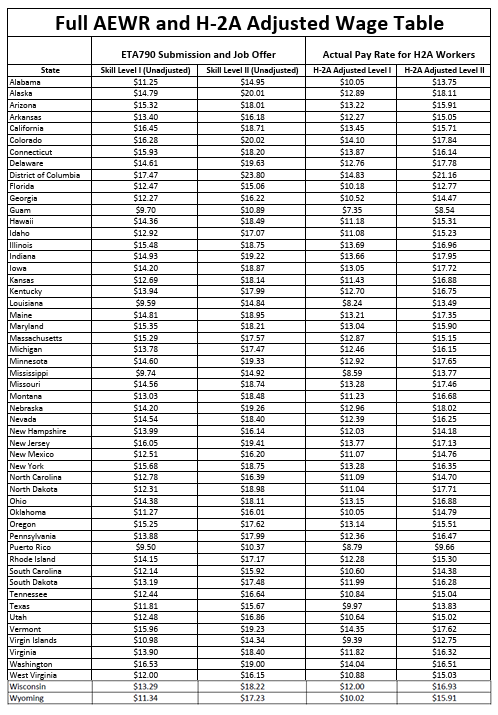New DOL Rule Changes How AEWRs are Calculated for H-2A Workers
Big changes are coming for employers who rely on the H-2A program.
On October 2, 2025, the U.S. Department of Labor (DOL) implemented an Interim Final Rule that reshapes how the Adverse Effect Wage Rate (AEWR) is calculated.
This shift from a regional rate to a two-level, skill-based, tiered system will have a direct impact on how wages are determined and how you operate within the program moving forward.
Instead of being calculated using the annual Farm Labor Survey (FLS) data from your region, the new AEWRs will be calculated using data from the Bureau of Labor Statistics (BLS).
The announced changes should give farmers operating under the H-2A program some much-needed reprieve from the high wage rates plaguing the program for the past several years.
At USA Farm Labor, we’re committed to keeping you informed and helping you stay compliant every step of the way. Our knowledgeable and dedicated staff have learned the ins and outs of the new calculation methods, and we’re here to support your operation.
Compliance Reminder
Employers cannot reduce wages on existing certified job orders. You must continue paying the full rate certified on your current contracts until completion.
The new AEWRs apply to job orders and certifications approved on or after October 2, 2025, so effective right away. Many of you will see the impacts of these new AEWRs when you recertify for the upcoming season.
How the New AEWRs Structure Works
The new AEWR is calculated using a two-tiered system to classify job orders. Now, your jobs will either fall into level 1 or level 2, depending on the amount of experience needed to successfully perform the duties associated with the role.
The experience requirement falls on the job itself, not the person applying for the job; their experience has no bearing on how you will calculate your AEWRs.
The AEWRs will be split into two levels – Level 1 and Level 2, based on the experience and skills needed to perform the job. Here’s a quick breakdown of job requirements for each level:
Level 1 AEWR (Entry-Level)
Based on the 17th percentile (lower one-third of wages).
Workers typically perform routine tasks under close supervision using common tools, following step-by-step instructions.
Applies when the ETA-790 lists duties with:
No formal education
Minimal or no prior experience (≤2 months)
Only short demonstration/on-the-job training
Example from the Department of Labor (DOL)
Up to 2 months of experience cultivating diversified vegetable crops, or a brief demonstration period lasting a few days to weeks.
Level 2 AEWR (More Experienced)
Based on the 50th percentile (median wage).
Workers are expected to operate with greater judgment, less direct supervision, and more skill.
Applies when the ETA-790 requires:
3+ months of prior experience
Certifications (CDL, welding, mechanic, etc.)
More skilled or complex farm duties
Example from DOL
3 months of experience operating complex row-crop equipment (e.g., GPS-guided planters and combines), calibrating spray equipment, and performing field adjustments independently to ensure correct application rates.
Effective Dates and Implementation
The new rule took effect on October 2, 2025. All new ETA-790 job orders filed on or after this date will use the two-level AEWR system. Here are some important details regarding the implementation of these new H-2A wage rates:
Rates will now update annually in July as opposed to December.
The current AEWRs will remain in effect until June 2026.
AEWRs have adjustments for those employers who provide Free Housing for their H-2A workers.
Domestic workers (U.S.-based workers) must be paid the AEWR in full before a housing deduction, regardless of whether they utilize employer-provided housing or not.
See the table below for your updated wage rates and notice the Housing Adjustments column.
What H-2A Employers Need to Know
Job order details are critical.
Listing qualifications like CDLs, mechanical skills, or months of experience must be accurate to ensure your jobs are classified with the correct wage rates.
The DOL and State Workforce Agencies will assign the SOC code and wage level based on the totality of duties and qualifications — not just the employer’s label.
New AEWRs and Housing Adjustments
When your jobs are advertised at the state level or at the federal level, such as on seasonaljobs.dol.gov, the advertised wage rate will include the full AEWR without the housing adjustment listed.
The full wage rate is listed for several reasons, but a lot of this has to do with the positive recruitment process, so your jobs are advertised properly to American applicants.
If you’re unable to source a qualified, willing American applicant and hire a foreign H-2A worker, then you are allowed to adjust their wage rate for the free housing you provide as part of the program’s requirements. You will see that the table above includes housing adjustments by state.
The Pros at USA Farm Labor are Here to Help
At USA Farm Labor, our team closely monitors these regulatory changes so you don’t have to. If you have questions about how the new AEWR structure may affect your contracts, or if you need assistance, we’re ready to guide you through the process and keep your business compliant.
Contact us today to discuss your labor needs and ensure you’re prepared for the upcoming changes.
You can read the original blog post that explains how the AEWR is calculated here:




